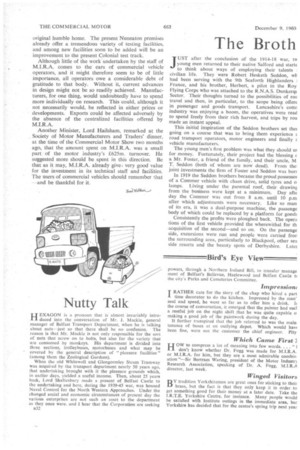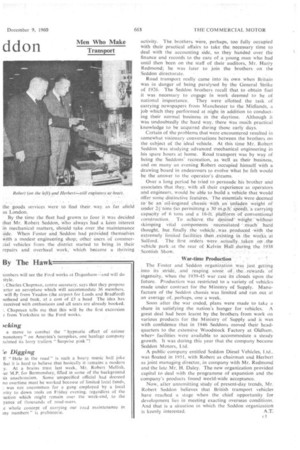The Broth (Won
Page 36

Page 37

If you've noticed an error in this article please click here to report it so we can fix it.
JUST after the conclusion of the 1914-18 war, tiA young men returned to their native Salford and starte to think about ways of employing their talents I civilian life. They were Robert Hesketh Seddon, w13 had been serving with the 9th Seaforth Highlanders 1 France, and his brother, Herbert, a pilot in the Roy, Flying Corps who was attached to the R.N.A.S. Dunkerqt Sector. Their thoughts turned to the possibilities of roe travel and then, in particular, to the scope being offerc in passenger and goods transport. Lancashire's con() industry was enjoying a boom, the operatives were read to spend freely from their rich harvest, and trips by roa made an instant appeal.
This -initial inspiration of the Seddon brothers set the' going on a course that was to bring them experience z road transport operators, motor engineers and finally 2 vehicle manufacturers.
The young men's first problem was what they should us for money. Fortunately, their project had the blessing c a Mr. Foster, a friend of the family, and their uncle, M T. Seddon (both of whom are now dead). From thei joint investments the firm of Foster and Seddon was bort
In 1919 the Seddon brothers became the proud possessoi of a Commer vehicle with chain drive, solid tyres and o lamps. Living under the parental roof, their drawing from the business were kept at a minimum. Day afte day the Commer was out from 8 a.m. until 10 p.m after which adjustments were necessary. Like so man of its era, it was a dual-purpose machine, the passenge body of which could be replaced by a platform for goods
Consistently the profits were ploughed back. The opera tions of the first vehicle provided the wherewithal for th .acquisition of the second—and so on. On the passenge side, excursions were run and people were carried free the surrounding area, particularly to Blackpool, other sea side resorts and the beauty spots of Derbyshire. Latex
the .goods services as London.
were to find their. way. as far afield
By the time the fleet had grown to .four it was decided that Mr. Robert Seddon, ,Who always had a keen interest in mechanical. matters, should take over the maintenance side When Foster and Seddon' had provided themselves with a modest -engineering shop; other users of comtnerHal vehicles from the district started to bring in their repairs and overhaul work, which became a thriving activity. The brothers were, perhaps, too fully occupied with their practical affairs to take the, necessary time to deal with the accounting side, so they handed over the finance and records to the care of a young man who had until then been on the staff of their auditors, Mr. Harry Redmond; he was later to join the brothers on . the
Seddon directorate.
Road transport really came into its own .when Britain was in danger of being paralysed by the General Strike of 1926. The Seddon brothers recall that to obtain fuel it was necessary to engage in work deemed to be of national importance. They were allotted the task of carrying newspapers from Manchester to the Midlands, a job which they performed at night in addition to conducting their normal business in the daytime. Although it was undoubtedly the hard way, there Was muCh -practical knowledge to be acquired during those early days.
Certain of the problems that were encountered resulted in somewhat visionary conversations between the brothers on the subject of the ideal vehicle. At this time Mr. Robert Seddon was studying advanced mechanical engineering in his spare hours at home. Road transport was by way of being the Seddons' recreation, as well as their business, and on many an evening Robert occupied himself with a drawing board in endeavours to evolve what he felt would be the answer to the operator's dreams.
Over a long period he tried to persuade his brother and associates that they, with all their experience as operators and.engineers, would_be able to build a vehicle that would dffer some distinctive feat tires. • The.eSSentials Were deemed to he an oil:engined: chassiS, with an unladen weight of Oder' 2-1-'tOns-(so permitting a 30 tri.p.h'f -1Peic1-.)a carrying capacity of 6 tons and a 16:.ft.plalform of conventional construction. To achieve. the desired'.weight--Without skimping vital components .necessitated much' . hard thought, but _finallY the -vehicle ._Wra.s .produced With -the extremely limited facilities then existing the work-s. at
Salford. The first orders were actuallytaken vehicle park at the rear of Kelvin Hall .during the 0-38 Scottish Show,
War-tithe Production
The Foster and Seddon organization was just getting _ ,
into its stride, . and reaping: some of the rewards of
ingenuity, when the 1939-45 war cast its clouds upon the future. Production was restricted to a variety of vehicles made under contract for the Ministry of Supply. Manufacture of the Seddon chassis was limited and ran out at an average of, perhaps, one a week.
Soon after the war ended, plans were made to take a share in satisfying the nation's hunger for vehicles. A great deal had been learnt by the brothers from work on various products for the Ministry of Supply and it was with confidence that in 1946 Seddons moved their headquarters to the extensive Woodstock Factory at Oldham. when-facilities were available to accommodate a steady growth. It was during this year that the company became Seddon Motors, Ltd.
A public company entitled Seddon Diesel Vehicles, Ltd.. was floated in 1951, with Robert as chairman and Herbert as joint managing director, in company with Mr. Redmond and the late Mr. H. Daley. The new organization provided capital to deal with the programme of expansion and the company's products found world-wide acceptance.
Now, after unremitting study of present-day trends, Mr. Robert Seddon believes that British transport vehicles have reached a stage when the chief opportunity for development lies in meeting exacting overseas conditions. And that is a situation in which the Seddon organization is keenly interested.
























































































































